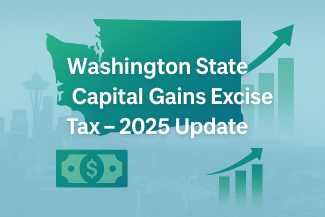
Washington State Capital Gains Excise Tax – 2025 Update
Washington imposes an excise tax on certain long‑term capital gains realized by individuals (including grantor trusts). The tax was first effective for the 2022 tax year at a single 7 % rate. Beginning with the 2025 tax year, the Legislature adopted a tiered structure:
Taxable Washington Capital Gains | Tax Rate |
|---|---|
$0 – $1,000,000 | 7 % |
Above $1,000,000 | 9.9 % (7 % base + 2.9 % surcharge) |
The surcharge was enacted by ESSB 5813 and applies to gains recognized on or after 1 January 2025. Returns covering 2025 gains are due 15 April 2026.
Standard Deduction (Inflation‑Indexed)
Each taxpayer receives an annual deduction that shelters a portion of net long‑term gains:
- Tax year 2024: $270,000 per individual (latest figure published by DOR).
- Tax year 2025: Will be adjusted for inflation; DOR will announce the new amount in early 2026. Until then, planners often model with ~$278 k based on CPI trends, but confirm the official figure before filing.
Married couples filing jointly effectively share a single deduction (it is not doubled).
Scope of the Tax
- Applies to Washington‑domiciled individuals (and resident trusts) on net long-term capital gains.
- Covers most sales of stocks, bonds, mutual funds/ETFs, and many business interests.
- Does not apply to real estate, qualified retirement accounts, assets transferred at death, certain livestock and agricultural property, timber & timberlands, and other statutory exemptions.
Updated Examples (2025 Rules)
Example 1: Gain Below the Tier Threshold
You realize a $300,000 long‑term gain in 2025.
- Assume the 2025 deduction is $270,000.
- Taxable gain: $30,000.
- All of it is within the first $1 million tier →
$30,000 × 0.07 = $2,100.
Example 2: Gain Above the Tier Threshold
You realize a $1.3 million long‑term gain in 2025.
- Deduction (assume $270,000) leaves
$1,030,000taxable. - First $1 million taxed at 7 %:
$1,000,000 × 0.07 = $70,000. - Excess $30,000 taxed at 9.9 %:
$30,000 × 0.099 = $2,970. - Total tax:
$70,000 + $2,970 = $72,970.
Filing Requirements & Deadlines
- File a Washington Capital Gains return if net long‑term gains (after exemptions/deductions) exceed the annual standard deduction.
- Returns are generally due the same day as the federal individual return (15 April unless extended).
- Estimated payments may be required if the tax will exceed $1,000.
Strategies to Manage or Reduce the Tax
The planning ideas below remain helpful under the 2025 rules, but note how the new 9.9 % tier can magnify savings for large transactions:
- Harvest Long‑Term Losses – Only long‑term losses offset WA‑taxable gains.
- Spread Asset Sales Across Years – Useful if each year’s net gain can stay below the $1 million tier break.
- Installment Sales – Similar to (2); structured correctly, can defer recognition across years.
- Charitable Giving to WA‑based Charities – Donations above the standard deduction (up to a cap adjusted annually; $108,000 for 2024) can reduce taxable gains.
- Change of Domicile – Gains realized after moving out of Washington are not subject to this tax (beware other states’ rules).
Conclusion
For 2025 and beyond, Washington’s capital‑gains excise tax is no longer a flat 7 %. Taxpayers with very large gains now face a blended rate that can approach 9.9 % on the portion above $1 million. Careful timing, loss harvesting, and charitable planning can meaningfully reduce exposure—especially in years when gains flirt with the new tier break. Work with your tax professional to model different scenarios once the Department of Revenue publishes the official 2025 standard‑deduction amount.

